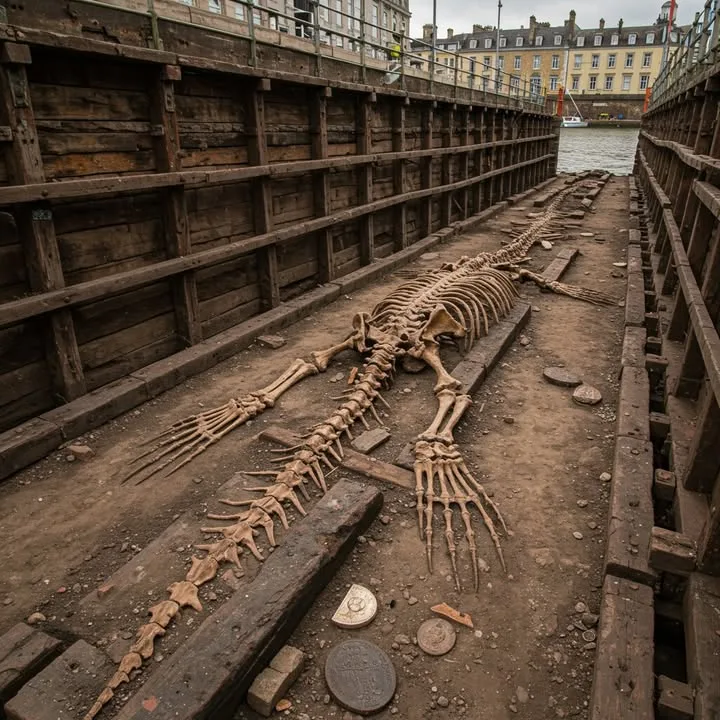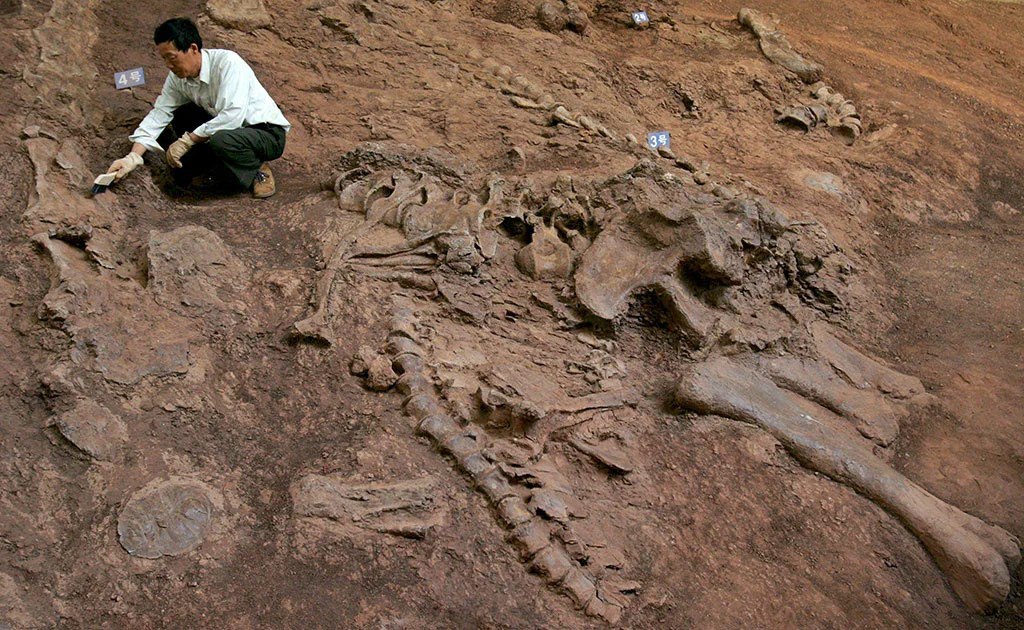We’ve all heard the stories—whispers from ancient mariners of serpentine beasts that could drag a galleon to the depths, of sirens luring sailors onto rocks, and of humanoid creatures watching from the waves. For centuries, we’ve dismissed them as fantastical myths, the products of lonely voyages and storm-tossed imaginations.

But what if one of those legends just washed ashore?
A viral rumor is snaking its way through the darker corners of the internet, claiming that a discovery of unimaginable scale has been made. The story goes like this: during a routine expansion of a bustling, unnamed European port, construction crews unearthed something that should not exist. A massive skeleton, unlike anything recorded in marine biology.
The Anatomy of a Mystery
The descriptions are chillingly specific, yet frustratingly vague. The creature is said to be colossal, dwarfing any known marine life. Its anatomy is the true shock: a bizarre fusion that echoes the most terrifying sea legends. It possesses clear, powerful humanoid limbs alongside the streamlined bones of an aquatic anatomy.
This isn’t just a strange new species of whale or a deformed shark. This, proponents claim, is something else entirely. It’s a physical specimen that directly mirrors the descriptions of ancient sea gods and monsters long dismissed as fantasy.
The Official Silence: Cover-Up or Common Sense?
This is where the story shifts from a simple “what if” to a full-blown conspiracy. Following the alleged discovery, a blanket of silence has supposedly fallen over the site. The rumor mill suggests that government officials swiftly descended, cordoning off the area and redirecting the narrative.
The question is, why?
The Conspiracy Theory: Believers argue that this is the evidence governments and scientific institutions have feared for centuries. Proof that our understanding of the ocean—which remains 95% unexplored—is fundamentally wrong. Validating these old maritime legends would not only rewrite history and biology but could potentially cause widespread panic, challenge religious doctrines, and undermine public trust in scientific authority. The silence, they say, is a controlled operation to bury the truth before it upends our entire worldview.
The Rational Perspective: Let’s put the puzzle pieces together with a dose of skepticism. The “silence from officials” is a classic trope that makes a story unfalsifiable; the lack of evidence becomes the evidence.
-
The Total Lack of Proof: There are no credible photos, no scientific reports, and no named sources. A discovery of this magnitude, at a busy commercial port, would be impossible to contain. Dozens, if not hundreds, of dockworkers, engineers, and local officials would have seen it. In the age of the smartphone, a secret this big would not stay secret for long.
-
The Biological Impossibility: The description of “humanoid limbs and aquatic anatomy” is a biological nightmare. Evolution simply doesn’t work that way. The skeletal structure required for a large, land-walking, tool-using primate is entirely incompatible with the needs of a large, deep-ocean creature. It’s a hybrid that belongs in a myth, not a fossil bed.
-
The More Likely Explanations:
-
A Masterful Hoax: This has all the hallmarks of a brilliantly crafted “creepypasta” or an ARG (Alternate Reality Game) designed to go viral. The vague location and sensational description are engineered for maximum shares and speculation.
-
Misidentification: The skeleton of a known prehistoric marine reptile, like a Plesiosaur or Mosasaur, can look utterly alien. Its flippers and long neck could be misinterpreted by a non-expert as “humanoid” features, especially when viewed through the lens of wanting to believe.
-
Art or Promotion: This could be a stunning piece of digital art or a sculpture, created by a talented artist, that was stripped of its context and released into the wild as a “real” discovery. This is a common origin for many modern internet myths.
-
Conclusion: A Story We Want to Believe
The tale of the Dockyard Leviathan is a powerful one because it taps into a deep, primal part of our psyche. The ocean is our final frontier, a place of immense mystery and fear. The idea that it could be hiding creatures straight out of our oldest legends is thrilling.
It’s a story that speaks to our desire for a world that still holds epic secrets, where the maps still have edges marked “here be dragons.”
But until a single, verifiable piece of evidence emerges—a clear photograph, a statement from a reputable scientific body, a peer-reviewed paper—the Dockyard Leviathan remains exactly where it has always lived: not in the cold mud of a European port, but in the rich and stormy seas of our own imagination.
It’s a fantastic story. But for now, that’s all it is.





